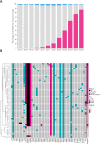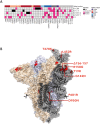Reduced neutralisation of the Delta (B.1.617.2) SARS-CoV-2 variant of concern following vaccination
- PMID: 34855916
- PMCID: PMC8639073
- DOI: 10.1371/journal.ppat.1010022
Reduced neutralisation of the Delta (B.1.617.2) SARS-CoV-2 variant of concern following vaccination
Abstract
Vaccines are proving to be highly effective in controlling hospitalisation and deaths associated with SARS-CoV-2 infection but the emergence of viral variants with novel antigenic profiles threatens to diminish their efficacy. Assessment of the ability of sera from vaccine recipients to neutralise SARS-CoV-2 variants will inform the success of strategies for minimising COVID19 cases and the design of effective antigenic formulations. Here, we examine the sensitivity of variants of concern (VOCs) representative of the B.1.617.1 and B.1.617.2 (first associated with infections in India) and B.1.351 (first associated with infection in South Africa) lineages of SARS-CoV-2 to neutralisation by sera from individuals vaccinated with the BNT162b2 (Pfizer/BioNTech) and ChAdOx1 (Oxford/AstraZeneca) vaccines. Across all vaccinated individuals, the spike glycoproteins from B.1.617.1 and B.1.617.2 conferred reductions in neutralisation of 4.31 and 5.11-fold respectively. The reduction seen with the B.1.617.2 lineage approached that conferred by the glycoprotein from B.1.351 (South African) variant (6.29-fold reduction) that is known to be associated with reduced vaccine efficacy. Neutralising antibody titres elicited by vaccination with two doses of BNT162b2 were significantly higher than those elicited by vaccination with two doses of ChAdOx1. Fold decreases in the magnitude of neutralisation titre following two doses of BNT162b2, conferred reductions in titre of 7.77, 11.30 and 9.56-fold respectively to B.1.617.1, B.1.617.2 and B.1.351 pseudoviruses, the reduction in neutralisation of the delta variant B.1.617.2 surpassing that of B.1.351. Fold changes in those vaccinated with two doses of ChAdOx1 were 0.69, 4.01 and 1.48 respectively. The accumulation of mutations in these VOCs, and others, demonstrate the quantifiable risk of antigenic drift and subsequent reduction in vaccine efficacy. Accordingly, booster vaccines based on updated variants are likely to be required over time to prevent productive infection. This study also suggests that two dose regimes of vaccine are required for maximal BNT162b2 and ChAdOx1-induced immunity.
Conflict of interest statement
The authors have declared that no competing interests exist
Figures



References
-
- Lopez Bernal J., Andrews N., Gower C., Gallagher E., Simmons R., Thelwall S., Stowe J., Tessier E., Groves N., Dabrera G., Myers R., Campbell C.N.J., Amirthalingam G., Edmunds M., Zambon M., Brown K.E., Hopkins S., Chand M. & Ramsay M. 2021, “Effectiveness of Covid-19 Vaccines against the B.1.617.2 (Delta) Variant”, The New England journal of medicine, vol. 385, no. 7, pp. 585–594. doi: 10.1056/NEJMoa2108891 - DOI - PMC - PubMed
-
- Greaney AJ, Starr TN, Gilchuk P, Zost SJ, Binshtein E, Loes AN, et al.. Complete Mapping of Mutations to the SARS-CoV-2 Spike Receptor-Binding Domain that Escape Antibody Recognition. Cell host & microbe. 2021;29(1):44–57 e9. Epub 2020/12/02. doi: 10.1016/j.chom.2020.11.007 ; PubMed Central PMCID: PMC7676316. - DOI - PMC - PubMed
Publication types
MeSH terms
Substances
Supplementary concepts
Grants and funding
LinkOut - more resources
Full Text Sources
Other Literature Sources
Medical
Miscellaneous

